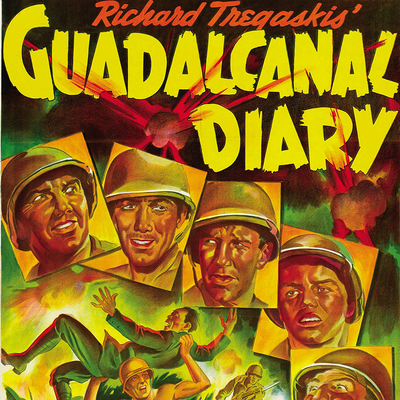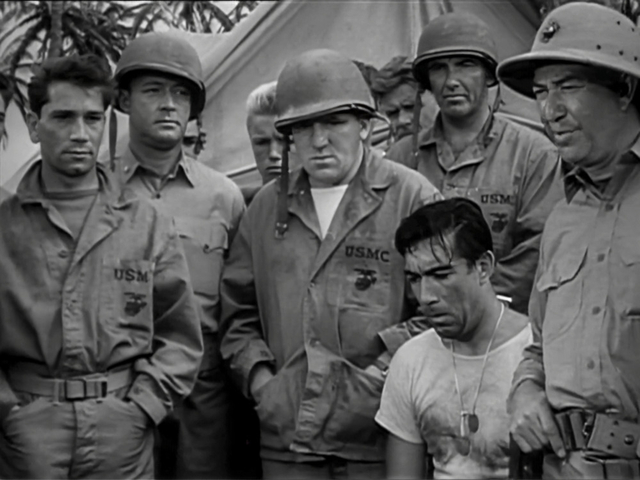

Posted on 11/19/2023 7:50:53 AM PST by Rummyfan
Guadalcanal Diary is the first real American combat document of World War Two, written by a war correspondent who had gone ashore with the Marines in the first U.S. ground offensive in the Pacific. Richard Tregaskis wrote it for an audience who were desperate to know what their sons, husbands, brothers and friends were experiencing as soldiers, fighting an enemy they probably hadn't given much though to just over a year earlier.
It's an actual diary, compiled from Tregaskis' notes, and amidst the accounts of encounters and movement and excitement and discomfort you'd expect from a diary, it has occasional moments of insight about what it's like to, say, emerge from your shelter after a bombing or an artillery barrage:
"When you finally get up to look around, you have butterflies in your chest and your breath is noticeably short and your hands feel a bit shaky. Those feelings do not seem to be avoidable by any conscious effort."
(Excerpt) Read more at steynonline.com ...


I read that book about sixty years ago! Great read along with Ernie Pyle’s books.
Been years since I have seen the movie.
I first read this when I was 11 or 12 years old.
Just after the war, many of the war movies about WW2 were not “comfortable”. You had to walk a tightrope between being realistic and being entertaining. My dad started the war during Operation Torch and ended it on Okinawa. He was the envy of his friends who served because he never fired his weapon. He was a Staff Sgt similar to Radar on MASH. He never had the nightmares.
Great book. I read this as a 12 year old back in the Sixties. Rendering it faithfully into a movie has not been adequately done. IMO.
In my opinion, the best approach via film I have seen is “The Pacific” series, where they show the fighting on Bougainville. The privation of the men, the assault by everything natural ranging from the humid, fungus filled climate to the deadly disease bearing insects, to the constant strain of combat is close, but not yet approaching the actual conditions for those of us who have not been there.
Ditto. Good read. Don’t really remember the movie.
I watched “The Battle of the Bulge” once with my grandfather. He saw it “in technicolor, on the original screening” as he put it. Anyway, I asked him what he thought afterwards, and he said “No one looked cold enough”.
Good observation, sez me. Now I judge war movies on how hot/cold, wet, dirty, hungry, and generally miserable the characters look.
I think Band of Brothers was probably the best that Hollywood can do.
The opening portion of the series “The Pacific” is devoted to Guadalcanal. It’s based on Eugene Sledge’s memory of that battle in his “With the Old Breed”.
The Pacific is able to show war a lot more realistically than what movies were able to do in the 1950s. The great Dale Dye served as advisor to the production. Well worth watching.
What really happens to nineteen year old young men in heavy combat can never really be “recreated “ in film or even books. Films and books may give others some idea of the emotions and horror but most veterans will never find the depictions totally spot on. It is a tragedy when necessity forces young men to engage in such horrors.
It seems a lot of us read it as young boys.
I don’t think boys read that sort of history today.
I first read this when I was 11 or 12 years old.
As someone pointed out a month or two ago, The Sergeant Pepper album is closer in time to WWI than it is to now.
For realism and closest to the actual situation and attitudes, I gave my vote to "We Were Soldiers". They had the forethought to bring the actual commander of the Ia Drang firefight into the production that really made sure they didn't stray off into the land of fiction. For action depiction of the battle they were right on. Talked to some of my guys at a Ft Benning reunion I asked those that saw the movie what they thought and got a resounding approval. The writers/producers really scored big with vets when the movie showed the shots from the wives and girlfriends back home waiting. Hard tugs at the heartstrings for the guys. A very real depiction of Air Assault in its infancy. I came in behind the 1965 guys at Ft Benning by just over a year when Air Assault had matured a bit and found it really on the spot.
Contrast the US Military of 1942 with the intellectually and morally confused military of 2023!
It's easy to see why America's enemies are emboldened. It's also easy to see the terrible danger that threatens the American People and the USA in 2023.
If the American People don't wake up fast, they're going to be in much greater danger--and in the near future.
But after serving in combat in Vietnam, my view of war movies became much more jaundiced. All war movies seemed contrived, comfortable and faked. They were cartoons, designed to make war seem easily endurable and not excessively scary.
Even Vietnam war movies were lousy: the directors/writers were intent on presenting their messages, rather than trying to show us (or the Vietnamese) in a favorable light. As with the previous generation's war movies, the firefights didn't at all sound like real firefights, gunfire sounded like blanks (which of course, they were) and grenades looked and sounded like trashcans full of gasoline being exploded by black powder.
Unlike earlier war movies, we Vietnam combatants were portrayed as witless stumblers (Forrest Gump, Deer Hunter) and/or war criminals (Platoon, Apocalypse Now).
I keep hoping for a good movie to made about us and what we did - but it likely won't come out until all of us who were there are long gone from this earth.
The only good thing FDR ever did, was pursue total war.
bkmk
Not on location such as yours, I was 15 feet from a 105, when it was fired. The sharpness of the sound, the crack in the air, was informative.
Later, I listened to a recording made by a British war correspondent, September 1944, of a German artillery barrage - the effects of the shells’ arrivals - at a location west of Arnhem, The Netherlands. With solid atructures and pathways paved in their target area, the sound, as if thousands of pots and pans all arrived and crashed at the same time, from great height . . . was informative.
From my studies, I learned that each individual’s sense of action and sound effects, varies. “The ‘report’,” varies.
.A 105 firing is a loud boom (I know that one very well, having served on a 105 gun crew for four months - and the only ear plugs we had were cigarette filters). When that 105 round arrived, it had a different sound entirely - a shattering "slam", a sharp crack.
Aircraft bombs are much louder and have a distinctive deep Steel-door-slamming sound - see the current videos of the Israeli bombs being dropped on Hamas strongpoints to hear what they sound like.
Rifle caliber weapons including machine guns have three sounds: the crack of the round leaving the muzzle of the weapon, the sonic crack from the supersonic flight of the round through the air and the "breaking pine board" sound of the round hitting something. You get a hundred or so men firing plus an equal number of the enemy firing in your direction, you get some idea of aural mayhem of a full-on firefight. And that chattering roar is punctuated every few seconds by the slam and whistle of the fragments of grenades being thrown.
Years ago, I had dinner with one of Hollywood's premier sound engineers - "Doc" Siegel. I spoke to him of the unrealism of the way war movies presented the sounds of weapons and he glared at me and said "we give them what the audiences EXPECTS to hear!" and that was the end of our discussion.
“Now I judge war movies on how hot/cold, wet, dirty, hungry, and generally miserable the characters look.”
I do that all the time, too. People may breath out clouds of steam, but nobody is shivering or freezing.
And it is not just war movies, either. My favorites are the 40s through 60s westerns where you see people riding the range for weeks or riding in bumpy, dust-filled stage coaches for days who emerge with freshly pressed, sparkling clean clothes, perfectly coiffed hair, and the ladies have perfect makeup on. The men get off their horses with spotless and freshly pressed shirts with nary a hint of dust or a smudge anywhere to be seen.
Ten minutes in my garden and I’m covered in dirt, grime and mud, but not those folks.
“I don’t think boys read that sort of history today.”
It’s so sad, isn’t it? I remember reading so many great books in junior high and high school in the 60s, none of which are taught today.
We were given it to read in fourth grade.
No trigger warnings.
Disclaimer: Opinions posted on Free Republic are those of the individual posters and do not necessarily represent the opinion of Free Republic or its management. All materials posted herein are protected by copyright law and the exemption for fair use of copyrighted works.